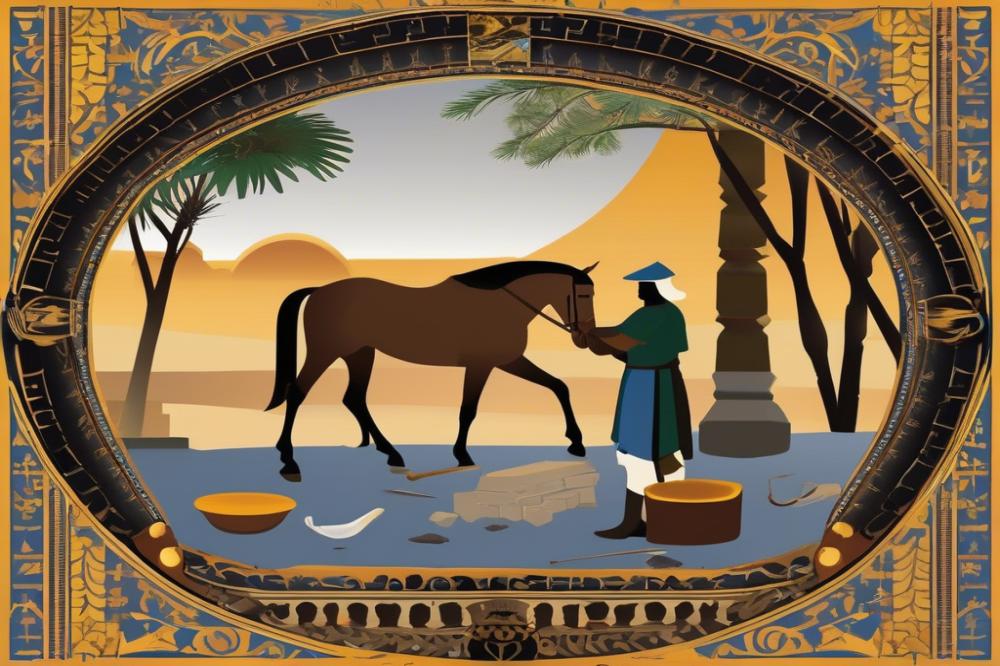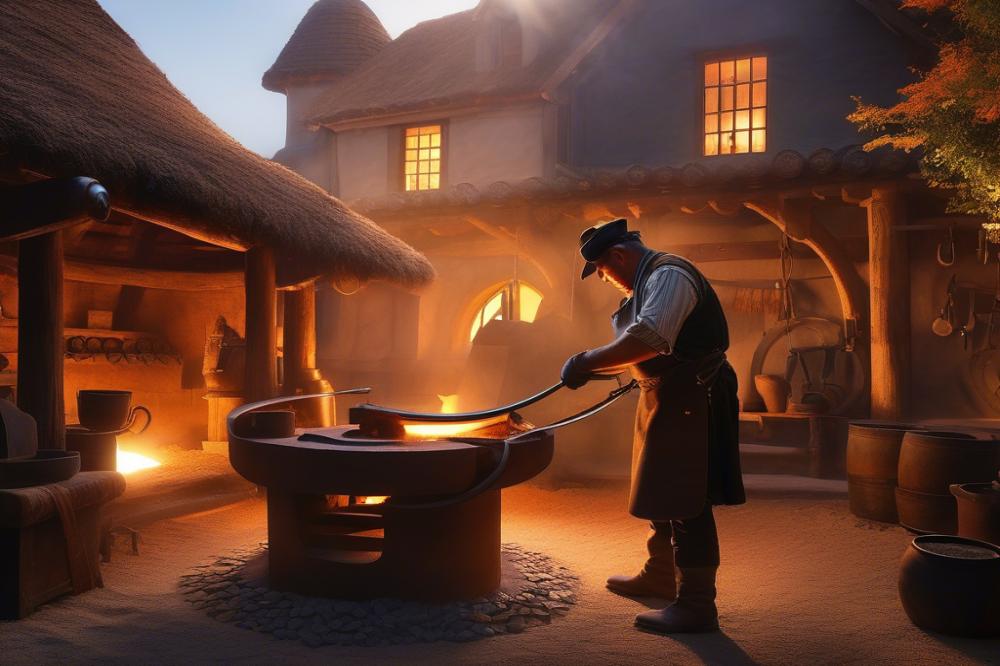Introduction
horseshoeing has played a crucial role throughout history, especially in the ancient world. The care of equines was essential for transportation, agriculture, and even warfare. Without proper hoof care, horses could suffer injuries, leading to severe consequences for their owners.
Farriery emerged as a specialized skill, developed to address the needs of horses. Ancient cultures recognized that healthy hooves were key to strong, reliable animals. As a result, techniques evolved to maintain and protect these valuable creatures.
In ancient Rome, farriers crafted shoes from metal, understanding that durability was necessary for various terrains. They relied on specific methods to fit these shoes to horse hooves. Alongside Rome, ancient Egypt also had unique practices for shoeing, often using materials like leather and plant fibers. Insights can also be found in other civilizations, where different cultures contributed to the body of knowledge on equine care.
This article will explore these ancient techniques and their significance. By examining the practices of Rome, Egypt, and beyond, we can appreciate how farriery laid the groundwork for modern equine care. The importance of hoof health cannot be overemphasized, as it continues to impact the welfare of horses even today.
Roman methods of horseshoeing

In ancient Rome, horses were vital for transport and military endeavors. This created a demand for effective methods to care for their hooves. Farriers, the specialists who worked on horses’ feet, played a crucial role in society. Their skills helped not only to maintain the health of horses but also to enhance their performance.
Romans used sophisticated metalworking techniques to create horseshoes. Iron was the primary material, sought for its strength and durability. Typically, iron would be heated until it glowed red-hot. Next, it was shaped with hammers on anvils or was pressed into molds designed for hoof shapes.
Horseshoes were designed in various styles. Some had a simple shape, while others featured intricate designs. Roman craftsmen understood the importance of fitting each shoe properly. A well-fitted horseshoe would alleviate pressure points and reduce the chance of injury. This careful approach reflected the Romans’ commitment to the physical health of their horses.
The role of a farrier extended beyond simply attaching shoes. These professionals also studied hoof health. They advised horse owners on grooming and maintenance. Their knowledge was essential for maximizing the lifespan and utility of the animals. Thus, farriers held a unique status in Roman society, respected for their expertise.
Roman innovations in horseshoeing transformed transportation methods. As the empire expanded, so did the demand for fast horse travel. The suitable use of shoes allowed horses to withstand rugged terrains without injury. This advancement facilitated trade and communication across vast distances, promoting economic growth.
Working closely with other metalworkers, farriers contributed significantly to Roman metallurgical advancements. Techniques for forging, welding, and tempering metals improved over time. Such progress fostered the development of more robust and reliable horseshoes.
In summary, the art of horseshoeing in Rome combined practical techniques with innovative thinking. The impact of farriers was profound, shaping transportation and economy. Through their dedication, horses thrived, supporting the great ambitions of an empire.
Egyptian Craftsmanship in Horseshoeing

The practice of shoeing horses in ancient Egypt showcases the skills of talented craftsmen. Egyptian horses, prized for their speed and strength, played a vital role in transportation and warfare. As a result, the Egyptians developed methods to protect and enhance the animals’ mobility.
Copper and bronze were the primary materials used for horseshoes, reflecting the resources available to them. These metals were often hammered into shape by skilled artisans. Unlike the iron horseshoes later seen in Rome, Egyptian craftsmanship focused on lighter materials to maintain the horse’s agility. The shoes would sometimes feature intricate designs, making them functional yet aesthetically pleasing.
Egyptians placed a great deal of importance on horses. These animals were not just a means of transport; they symbolized status and power. Pharaohs rode majestic steeds, often depicted in art and hieroglyphics. This cultural significance drove the need for innovative techniques in shoe fitting and maintenance. Horses required shoes that adapted well to the terrain of the Nile and surrounding regions.
Comparatively, Roman practices evolved as trade and military conquests expanded. Roman horseshoes were typically made from iron, providing durability for longer journeys. While both cultures recognized the necessity of shoeing, their approaches reflected different environments and available resources. Egyptians prioritized lightweight designs, while Romans favored stronger materials for greater distances.
The ancient Egyptians often used various tools to attach shoes to horses’ hooves, including nails or glue. Each horse was treated with care, considering its specific needs. Craftsmanship was not merely about function; it was an art form connecting cultural identity with practical use. Through thoughtful techniques, the Egyptians fortified their beloved horses while also maintaining a cultural legacy.
Horseshoeing in Other Ancient Cultures
Various ancient civilizations developed techniques for protecting horse hooves. In China, farriery practices date back over two thousand years. They often used iron to create protective coverings. These early horseshoes differed from those used in Rome or Egypt. In fact, they focused on molding metal to fit the horse’s hoof shape. This method demonstrates an understanding of horse anatomy that was quite advanced for its time.
Persia, known for its rich equestrian traditions, had its own unique approaches. Persian farriers aimed for both functionality and aesthetics. They decorated their horseshoes with intricate designs. This showed how horses symbolized status and power. Additionally, horses were vital for transport and warfare throughout the Persian Empire. Good care of these animals was paramount.
The Celts had their own distinct methods of hoof care and shoe attachment. Rather than nailed shoes, they often used rawhide or leather to cover the hooves. This reflects their connection to the natural environment. Riders believed these materials were sufficient for the terrains they navigated. Furthermore, they embodied a different cultural significance surrounding the horse. The Celts viewed horses as sacred creatures, emphasizing their importance in daily life.
Across these ancient cultures, there are noteworthy similarities in the purpose of hoof protection. Care for horses was practiced in each civilization, showing respect for animals that were essential to survival. However, methods varied based on local resources and traditions. Romans leaned toward heavy metal shoes, while Celts prioritized lighter materials. Each culture revealed its values through such practices.
Beyond practicality, horses represented various meanings. In many societies, they were symbols of strength, honor, and freedom. The bond between humans and these creatures shaped cultural narratives. The techniques employed in horseshoeing often reflected this bond, highlighting a deep-rooted relationship that transcended mere utility. Understanding these connections gives insight into how ancient cultures viewed the role of horses in their lives.
Evolution of Horseshoeing Practices
Over the years, horseshoeing techniques have changed significantly. Ancient practices often relied on the natural toughness of the horse’s hooves. In regions like Egypt and Rome, early farriers used simple tools to trim and protect these hooves. Leather and plant materials were commonly used to construct protective coverings. These methods served their purpose, yet they had limitations.
As societies progressed, so did their understanding of equine care. The introduction of metal shoes marked a major advancement in hoof protection. Bronze and iron became popular materials. With these, horses received better support on rough terrain. Farriers learned to shape the metal into fitted designs, improving both comfort and durability.
Medieval Europe witnessed another evolution in horseshoeing. The techniques of that time included nails to secure metal shoes firmly to the hoof. This innovation provided better stability and extended the life of the shoe. Additionally, the art of crafting different shoe types emerged, catering to various activities such as farming, war, or leisure riding.
Modern farriery still reflects practices from ancient times. Today’s farriers maintain a focus on the horse’s overall health. They combine traditional skills with contemporary veterinary knowledge. A balance is struck between artistry and science, as hoof care techniques continue to advance.
In crafting horseshoes, metalworking techniques have also evolved. The intricacies of metallurgy allow for lighter, stronger products. Innovations like thermally treated steel or aluminum offer alternatives that enhance performance. Such progress benefits both the horse’s function and the rider’s experience.
While methods have changed, the core idea remains the same. Protecting the hoof is of the utmost importance. Ancient practices laid the groundwork for today’s sophisticated approaches. Farriers carry the legacy forward, blending history with modern techniques.
Final Thoughts
Horseshoeing in the ancient world highlights the vital role of equine care. In Rome, techniques reflected a blend of practicality and artistry. Roman methods were developed to accommodate the needs of war horses and laborers alike. Egypt also played a significant role, introducing strong elements of craftsmanship that would influence future generations.
Historical practices varied greatly across cultures. Each region brought forward its own traditions and innovations. In some cases, techniques were closely linked to the society’s agricultural and military needs. The shoemaking practices of ancient civilizations laid the foundation for modern approaches to horse care.
Preserving such rich traditions remains essential today. Understanding how ancient societies managed their horses can improve current practices. It allows modern farriers and horse owners to appreciate the depth behind every technique and tool used in equine care. Learning from the past provides insight into how we care for these animals now.
The legacy of ancient horseshoeing continues to resonate. Elements of ancient Egyptian craftsmanship and Roman methods are still present in contemporary practices. By exploring these historical roots, we can honor those who paved the way. Embracing this knowledge ensures a future where the health and well-being of horses are prioritized.



